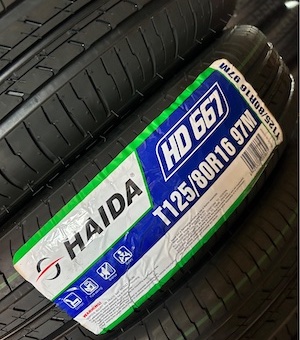How to read tire readings correctly?
A safe and smooth ride, optimal vehicle performance and lower fuel consumption - these are not the only features that are influenced by the right tyre choice. Their values can be found on the sidewall, in the rubber part of the tyre. All manufacturers must comply with the uniform marking because they are subject to a European Union directive. Do you know which mandatory information you will find on your tyre?
What purpose is the tyre marking actually used for?
The most important thing to remember is that the tyre has a major influence on the vehicle's handling. A smaller tyre diameter can make for an uncomfortable ride, a wide tyre can be noisier and negatively affect fuel consumption. So trust the information on the tyre from the manufacturer and always check it against the information on the technical certificate. Always take into account the terrain, road surface, time of year and current weather.
Tyre information also via QR code
Although it is not mandatory for manufacturers to include a QR code on the tyre label, most of them provide this information to customers. It not only provides information about the manufacturer, but also specific technical data to make it easier to choose the right type. The user can thus find out all the detailed information, such as the year of manufacture, safety data, technical specifications and, in some cases, the instructions for use, virtually instantly via a mobile device.
For space-saving spare wheels, manufacturers do not provide QR code information in most cases, but the mandatory technical data is always included.
For example, the following information is shown on the sidewall of a normal tyre:
205/55 R16 91 H
205 = tyre width - the figure is given in millimetres. It can be found in the vehicle's technical certificate.
55 = tyre side profile in %. It is always the ratio of height to width of the tyre (55% of 205 = 113 mm)
R = radial construction tyre, letter D diagonal and B mixed construction
16 = inner diameter of the tyre in inches (1 inch = 2.54 cm). This figure must be the same as that on the rim of the disc
91 = weight index - the maximum possible load on one tyre. This is not a specific weight figure, but only an index. This figure can also be found in the vehicle's registration certificate. For convenience, the specific values are given in the table below.
H = figure with maximum permissible speed. In this case, the maximum speed is 210 km/h. Common designations are also Q, R, S, T, U, H, V, and ZR.

For space saver spare wheels, the markings are different, but just as important.
T125/70 R16 96 M
T = Temporary (i.e. an indication uniquely identifying the space-saving spare tyre)
125 = tyre width - the figure is given in millimetres.
70 = tyre side profile
R = radial construction tyre, letter D diagonal and B mixed construction
16 = inner diameter of the tyre in inches (1 inch = 2.54 cm). This figure must be the same as that on the rim of the disc
96 = weight index - the maximum possible load on one tyre. This can be found in the vehicle's technical certificate. As mentioned above, it is always important to add the weight in kg to the index value and then multiply this by 4, as the vehicle has 4 wheels. In this particular case, index 96 = mass 710 kg x 4 wheels = maximum possible load 2 840 kg.
M = maximum possible speed for space-saving spare tyres is 80 km/h.
Chcete mít jistotu dojezdu i při cestách na dovolenou? Choose a vehicle brand, e.g. Audi, BMW, Opel, VW, VOLVO, mark the vehicle type and check the parameters against the information in the vehicle registration certificate.


Recommended:
Please note that the space saver wheels are only intended to take the vehicle to the nearest workshop where it must be replaced with a full size tyre.

